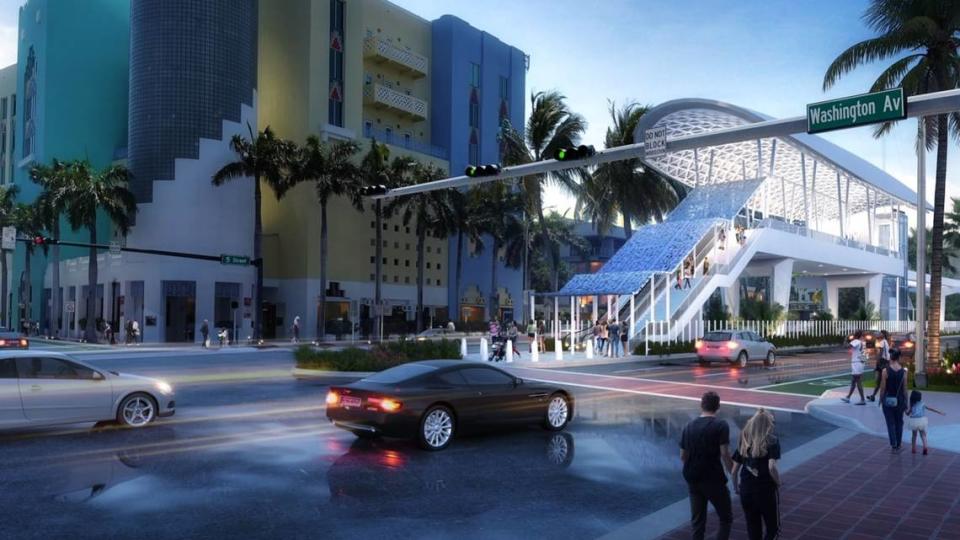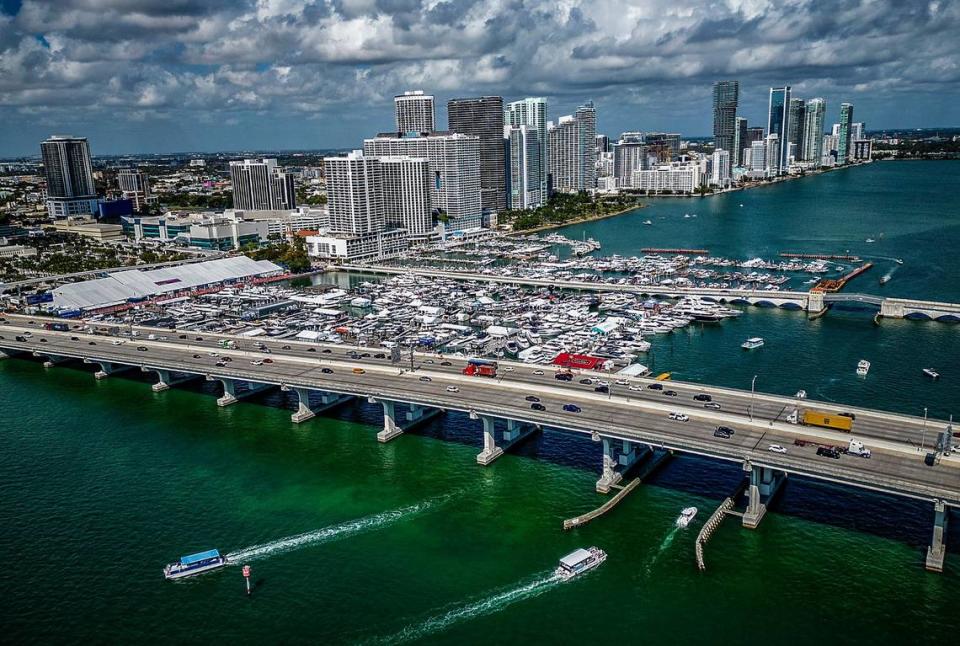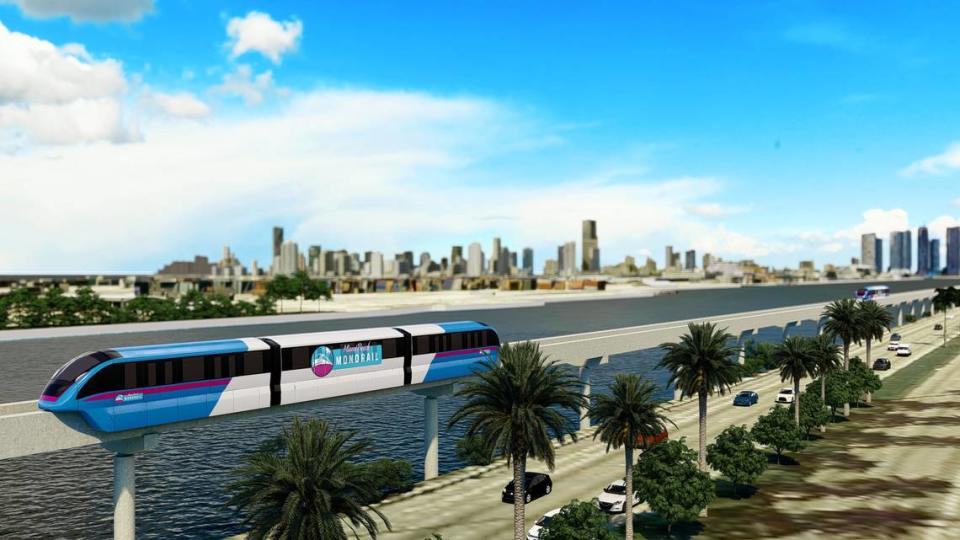Despite traffic gridlock, Miami Beach votes to oppose Metromover extension
- Oops!Something went wrong.Please try again later.
The Miami Beach City Commission is unanimous in opposing a Miami-Dade County plan to extend the Metromover to South Beach, voting Wednesday to object to what could become the first mass transit option connecting Miami Beach to the mainland.
All six city commissioners and Mayor Steven Meiner cosponsored a resolution opposing the “Baylink” plan and approved it without discussion.
The resolution calls for the county to pursue alternative options — like express bus lanes over the Julia Tuttle Causeway to the Mid Beach area — rather than sticking with the Metromover extension plan that would connect two existing stations in downtown Miami to two new stations along Fifth Street in South Beach. The Metromover, a free elevated transit system that operates in downtown Miami and Brickell, began service in 1986.
Homeowners in the South of Fifth and West Avenue neighborhoods, which are directly south and north of the planned stations, have railed against the Baylink and pressed elected officials to do the same.
City Commissioner Laura Dominguez said Tuesday that the Julia Tuttle Causeway alternative would be far preferable.
“You’re not affecting homes and businesses the way you would on the MacArthur,” Dominguez said. “A lot of times with projects, it really helps to have community support and buy-in, and the community really does not support this.”
The City Commission’s vote Wednesday comes even as Miami Beach residents lament traffic gridlock in the city, a long-standing problem that most recently resurfaced last weekend during the Miami International Boat Show.
At a virtual meeting with residents Tuesday evening, Meiner noted that the conversation had “shifted” over the past year. Meiner’s predecessor, Dan Gelber, praised the Baylink alternative in November 2022 as “a more convenient and common-sense transit option” than a proposed monorail operated by casino owner Genting, a plan put on the table in 2019.
But in February 2023, amid opposition from some neighborhood groups, Gelber and the City Commission declined to support the Metromover project, instead flagging concerns to the county about its implications for development.
“It’s really this specific iteration of the Baylink that we’re saying, ‘This is not the right option,’” Meiner said Tuesday.
Miami Beach’s approval isn’t needed for the Metromover project, which is set to be funded with county and state dollars and under Miami-Dade control. Still, the opposition from the City Commission and affluent neighborhoods along the proposed route set up the possibility of well-funded legal challenges.
“We look forward to bringing them updated information,” Miami-Dade Mayor Daniella Levine Cava said in a brief interview at the Stephen P. Clark Government Center after the Miami Beach vote.
Fisher Island, where wealthy residents depend on a ferry station off the MacArthur, has also pushed back on the plan. Last year, a lawyer for the island’s community association said in a letter to the county and the U.S. Coast Guard that there are “significant shortcomings” in environmental studies needed for federal approval of the project.
‘We are getting a bad deal’
City officials have made an assortment of arguments against the Baylink, including that some of the city’s largest employers, such as Mount Sinai hospital and the Fontainebleau hotel, are located in Mid Beach, not South Beach. Officials have also cited concerns that the county could control zoning around new Metromover stations.
Commissioner Kristen Rosen Gonzalez said Tuesday that the Metromover is “old technology.”
“That makes no sense because taxpayers are paying a price tag for cutting-edge technology,” Rosen Gonzalez said in a text message. “We are getting a bad deal.”
Neighborhood leaders have insisted they are opposed to the Baylink plan as it’s currently constructed, not to public transit in general.
Keith Marks, president of the South of Fifth Neighborhood Association, said Tuesday that the Metromover would drop people off at Fifth Street “with nowhere to go,” although the county’s $1 billion predicted construction price tag includes bus lanes linking the new stations with the Miami Beach Convention Center.
“Don’t twist it to say we’re against public transportation,” Marks said. “We do believe that traffic needs to be improved. We’re not asking to stop the progress on that, just to do new studies and look at better alternatives.”
Tim Carr, president of the West Avenue Neighborhood Association, said express bus lanes on the Julia Tuttle or the MacArthur would be a more cost-effective option than the Baylink. “We encourage mass transportation, but we encourage smart transportation,” he said. “We actually have the solutions in front of us right now.”
The groups have been steadfast in their opposition over the past year. Last February, South of Fifth residents voiced their displeasure during a meeting with County Commissioner Eileen Higgins at the Murano Grande luxury condo building, at one point chanting, “Stop the train!”
John Stimmel, president of an owners association for the Icon condo tower in South Beach, said at that meeting that the Metromover, the county’s only free transit option, could bring “more crime” and homelessness to Miami Beach.
READ MORE: ‘Stop the train!’ South Beach buses are packed, but county’s rail plan under attack

Support for a South Beach connection
Matthew Gultanoff, the director of pedestrian and transit advocacy group Better Streets Miami Beach, said the arguments against the Baylink are flawed.
Utilizing the MacArthur Causeway makes sense, he said, because South Beach is the “economic engine” of Miami Beach and connects to multiple transit options in downtown Miami. U.S. Census Bureau data show the highest concentration of jobs in the city is in South Beach.
“Everyone knows there’s an issue with traffic in the city, and it rears its ugly head during every high-impact special event,” Gultanoff said. “It’s clear that it’s the combination of large special events and a commuting workforce, many of whom work in these high-end buildings where many of the detractors live.”
Many Miami Beach residents want the Baylink, added Gultanoff, who lives in the South of Fifth neighborhood. Several neighborhood associations, including Flamingo Park and Palm View in South Beach, expressed their support last year.
“There needs to be a conversation that’s inclusive of everyone in this city and not just a few,” Gultanoff said.
In a letter to the City Commission last February, the Palm View Neighborhood Association wrote that “the traffic plaguing the neighborhood and surrounding area has become untenable.”
“Our ability to access local services and nearby neighborhoods on the mainland has become limited,” the group said. “We note that the only solution to this problem is to invest in more efficient transportation infrastructure.”

Decades without a solution
A mass transit option between Miami and Miami Beach has been on Miami-Dade’s wishlist since the 1980s. In 2004, Miami Beach voters endorsed a light-rail system over the MacArthur, but the project never advanced.
More recently, city officials have pursued a host of steps to try to address traffic gridlock. They have worked with the county and state to monitor traffic so they can alert residents of backups in real time, adjusted traffic signal timing at key intersections to synchronize lights, and hired new officers dedicated to directing traffic.
At a meeting last October, officials said none of those steps address the root of the problem: too many cars on the road. The Florida Department of Transportation considers several of the city’s main traffic arteries — including the MacArthur Causeway, 41st Street and parts of the Julia Tuttle Causeway — to be at a “failing” level of service, meaning travel demand exceeds roadway capacity.
“The issue is one of capacity,” Miami Beach Transportation Director José González said at the October meeting. “Signal timing alone provides only marginal improvements and cannot solve capacity issues we have in our city and our region.”
Officials are also working with a private company to revive a ferry service between Sunset Harbour and downtown Miami. And the state has been working on providing faster bus service across the Julia Tuttle Causeway by having buses use the shoulder as an express lane. Miami Beach has committed $5.1 million toward the effort.

Slow progress on Baylink
Meanwhile, progress on the proposed Metromover extension has been slow. Higgins and Levine Cava released a video in November 2022 announcing the administration was killing a stalled plan for a monorail line to the beach and moving forward with plans for a Metromover extension.
READ MORE: Miami-Dade mayor scraps monorail plan. Now pushing for Metromover extension to beach
At the time, Levine Cava announced an expedited bidding process that would get a development contract to county commissioners within 12 months. That would have allowed construction to begin as early as 2025, with operations expected in 2029.
But the project remains on the drawing board, and the county hasn’t released the bidding paperwork. The county’s budget still predicts construction will begin sometime in 2025.
Miami Herald staff writer Douglas Hanks contributed to this report.

